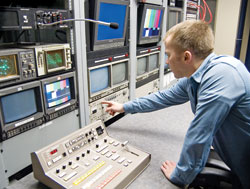Concordia Corner
Studios teach teamwork and TV production

Technician Mike Smart demonstrates the potential of the control room. The monitors track all studio action.
Photo by Rob Maguire
Communications students here have both theory and practice integrated into their program.
“Our BA program is not structured into a production stream and a study stream. Our curriculum is both,” said Martin Allor, an associate professor of Communi-cation Studies. He has been teaching both for years, ensuring that students get hands-on experience in addition to theory.
Production experience means production facilities.
Journalism and communications students have benefited from several on-campus studios over the years. The facilities in the Bryan Building were replaced by studios in Hingston Hall when the departments moved. Now they are in the basement of the CJ Building.
“It’s very typical of a small community TV station,” said Mike Smart, the technician responsible for familiarizing students with the facilities, equipment and possibilities.
With a three-camera production studio, two smaller shooting stages with green screen and blue screen technology, a control room and an editing suite, there is a lot of potential. There are sound recording studios as well for audio work.
Students in their second year are required to produce a full three-camera, live-to-tape production using the facilities.
The challenge is not just to define and script a show, but also to figure out who will manage the three cameras, who will direct the show and how the lighting, art direction and titles will get produced. Allor said it’s impossible to operate a studio of that size and complexity with fewer than a dozen people managing cameras and controls.
A production requires the coordination of the schedules, interests and abilities of a dozen students. Compromise and a lot of juggling are as necessary as technical ability. Since the class usually has twice that many students, the other half do field work and edit their tape into the final package.
“It really builds teamwork among the students,” Smart said.
The theme and type of show is entirely up to the students, though magazine style shows tend to accommodate input from all students.
Because the facilities are soundproof, they are also in demand as sets for other projects. Film students and others use the space.
The blue screen facilities allow the opportunity to develop special effects. “Multi-media and inter-media students can use the studios for web-based projects,” Allor said.